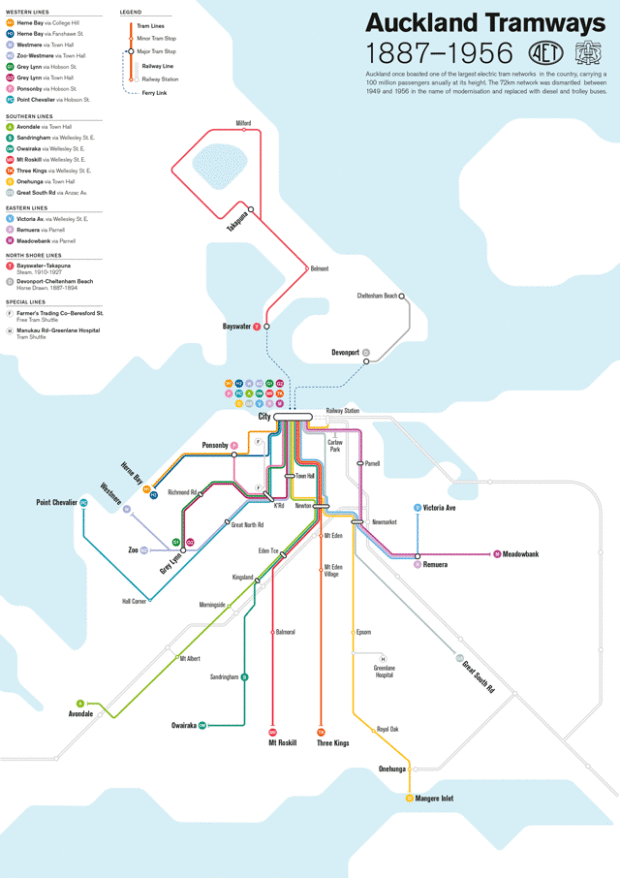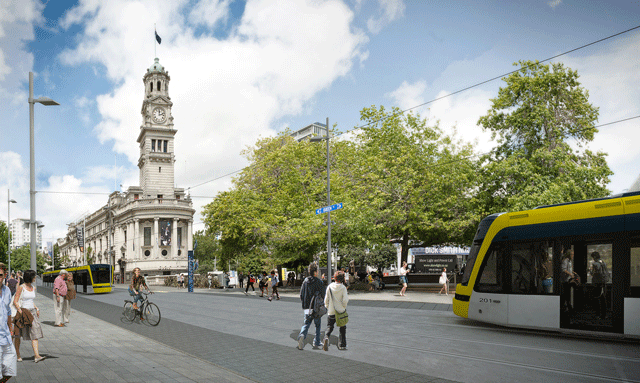Aug 5, 2015 Urban design
Great swathes of the most desirable parts of Auckland were built by the tram. All those lovely, leafy suburbs of the isthmus are the way they are because of the Edwardian electric tram network they grew around.
The clusters of shops at every stop, with rooms above for habitation or commerce, the short cut paths connecting back streets to long arterials. The width of Jervois, Richmond and Great North Rds, the odd bulges that mark the turning points outside the zoo or in front of the Empress Garden restaurant in Herne Bay.
Those trams were run pretty well too: “Always a tram in sight” was the saying. With five-minute headways, they had proper turn-up-and-go frequency.

Wildly popular and running at an operating profit, the trams by the 1950s needed upgrading — but instead, the modernisers and roads lobby seized the moment and they were gone. Melbourne invested in its trams, but in Auckland the city engineer waved away public outcry with the phrase: “It’s a technical matter.”
Could the trams be about to return? Yes, if Auckland Transport has its way, just as they are returning now to Los Angeles, Sydney, the Gold Coast and about 200 other cities worldwide. Not on all the old routes, of course, and not with the old rattlers from a museum, but with slick, new, highly functional and attractive European machines. Think of trams as streetcars; think of the system as light rail.
AT hasn’t proposed this for nostalgic reasons. The old isthmus routes are now bursting with buses and, if we keep adding more, traffic will grind to a halt. So, instead of a bus with 50-60 people on board every 60 seconds which fights through traffic, AT is proposing a streetcar with 300-450 passengers every five minutes. Better for public transport users; better for drivers.
The first route would take in all of Dominion Rd and the length of Queen St. This would mean taking the buses off Dominion Rd and the crowded inner-city streets. It would also mean removing cars from Queen St, so it would become like Bourke St in Melbourne: only delivery and emergency vehicles can enter, along with quiet streetcars running on largely renewably generated electricity.
No diesel-fume-belching buses or other polluting and street-clogging vehicles in the Queen St valley. More pedestrian space and other place improvements: it would mean a profound revolution not only in access but also in quality for both the old suburbs and the heart of the city.
On Dominion Rd, planning regulations would need to allow new buildings with apartments and offices above shops, as light rail creates the economic conditions for replacing the current low-value buildings. The reflex anti-change lobby will have to be stared down.
The light-rail plan complements the proposed City Rail Link (an underground system beneath the central city) that would deliver huge numbers of people to and through the city from west, east and south. Light rail would pick up the increasing volumes from the central isthmus.
AT predicts these rail systems would carry around 100 million passengers a year by the 2040s. That’s 100 million trips that would mostly have been in single-occupancy private vehicles, causing hideous road congestion for other drivers and, importantly, for road freight.
Drivers who need to use the roads or are desperately keen to keep doing so would be among the biggest beneficiaries of light rail.

But that’s not all. From the bottom of Queen St, the streetcars would turn west and head to the growing Wynyard Quarter. This offers the very real possibility of then slipping them under the harbour to a balancing set of destinations on the North Shore. To Takapuna, up Onewa Rd to Glenfield, down Lake Rd maybe but, easiest and most efficiently of all, straight up the busway to Albany and beyond.
To upgrade the existing Northern Busway to light rail would require little more than track to be laid. The route and the stations are already in place. Light rail is the most effective way to add capacity, resilience and choice to crossing the harbour.
A pair of narrow tunnels carrying only electric vehicles would be so much cheaper and less invasive than multi-lane road tunnels with enormous interchanges and exhaust stacks, as are currently proposed — at a construction cost of $6 billion.
They would be cheaper to build and with far greater capacity, too. Those road tunnels will peak at 6000, while rail tunnels would be able to carry 18,000 to 24,000 people an hour — without disgorging thousands
more cars onto city streets and into Spaghetti Junction.
How will we pay? AT is negotiating with a European supplier that would deliver the trams, build and run the network with no payments made until the system is operating.
The plan is to time this for after construction of the proposed City Rail Link. AT says because of the scale of the operational savings (fewer vehicles means fewer drivers, and electricity is cheaper than diesel), the city would be paying no more to build and run the whole light-rail system than it would merely to run the volume of buses it replaces.
Sixty years ago, Auckland made a critical decision: we took out the trams and committed the city to the private motor vehicle. Now we’re approaching the limits of that decision. If we keep building more roads, we won’t ease congestion: on the contrary, we will simply encourage more drivers to use them. The only viable option is to develop strategies to take cars off the roads. Light rail is a vital component of that.
It’s not just a transport issue, either. Trams and trains are about place and permanence. Flexibility may be the great virtue of the car but the reverse is true for these systems: when you lay railway tracks you are attesting to the permanence of the life and business along the chosen routes. Railways create a bedrock of confidence for long-term investment. They are a sign of a city that believes in its form and future.
It is no accident that the two main city routes under consideration for light rail are Queen St and Symonds St through the university. The very nature and economic purpose of these streets derive from the high numbers of pedestrians, yet both are dominated by too many vehicles. It’s time to change that. It’s time for the city to say, this is who we are and with this — the reinvention of the trams of the past — we will unlock our future.





